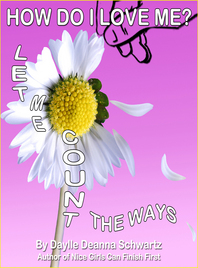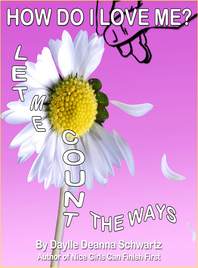 I’m delight to have Tina Tessina, Ph.D. back as my guest. Her articles always bring a great response as she has such a great take on life’s ups and downs. Tina is a licensed psychotherapist in private practice in California. She is the author of MANY books. Tina also writes the “Dr. Romance” column on Yahoo! Personals and MUCH more! Today she talks about recognizing who your real best friend is, or should be.
I’m delight to have Tina Tessina, Ph.D. back as my guest. Her articles always bring a great response as she has such a great take on life’s ups and downs. Tina is a licensed psychotherapist in private practice in California. She is the author of MANY books. Tina also writes the “Dr. Romance” column on Yahoo! Personals and MUCH more! Today she talks about recognizing who your real best friend is, or should be.
by Tina Tessina, Ph.D
I have a friend, Maggie, who has been my friend since 1968, and she calls me her “bestest” friend as a way of appreciating our connection. It always makes me smile, and I feel the same about her. Often, my clients have trouble learning to appreciate and trust themselves, and I think Maggie’s phrase should apply to the only relationship we’ll have from birth to death–the relationship with self. Are you your own bestest friend?
Whether you realize it or not, the relationship you have with yourself sets the pattern for how you connect with others. By developing a nurturing way to relate to yourself, you create a personal experience of both giving and receiving friendship.
Best of all, you’ll have greater trust in your decision-making ability when you recognize yourself as your own best friend. When you become comfortable with a constructive inner dialog, you can create an inner support system–you’ll become more confident in your evaluation of your thoughts, feelings, and options. The following exercise explores how you treat yourself as a friend and builds on your discoveries in the previous exercise.
Journal Exercise: Developing Inner Friendship
Get out your journal and find a comfortable place where you won’t be disturbed, and write the answers to the following questions:
1. How do you relate to yourself?
• Are you supportive of yourself?
• Do you seek your own opinion or ignore it?
• Do you consciously talk over decisions with yourself before you make them, or just worry ineffectually about them?
• Do you enjoy time with yourself, or avoid being alone?
• Do you celebrate your accomplishments and successes?
• Do you motivate yourself to do well?
• Do you tend to criticize everything you do?
Add any other aspects of how you relate to yourself:
2. Compare your internal relationship with your definition of friendship. You may be dismayed to find out you treat yourself quite differently from the way you treat friends. You might keep promises to a friend, but often renege on promises you make to yourself. You may not treat yourself with kindness and respect. Perhaps you mentally “nag” or criticize yourself. You may never break a date with a friend, but keep putting off your time with yourself. The best test of your friendship with yourself is: If someone else treated you the way you treat yourself, would you want to be her friend?
3. Becoming a friend to yourself. In the previous exercise, you discovered the kind of friendship you enjoy. Now that you have compared your way of having an external friendship with your way of having an internal friendship, you have some more work to do.Decide to improve the way you treat yourself and put your decision into effect by developing three simple ways you if doing so.
One way to approach this task is to treat yourself as you would treat a good friend. Ask yourself, “What would I do for Maggie if she were in my shoes? What would I say to her?” It’s likely that you’re usually kinder to her than to yourself. How would you speak to your friend if you thought she forgot to do something? Do you treat yourself more harshly? By comparing the way you treat yourself with the way you treat your friends, you will begin to develop clear guidelines about how to be your own friend. Write down your ideas about befriending yourself, and put them into action.
4. To develop trust, be consistent. You must be consistent in order to create an internal bond, and a strong habit of being a good friend to yourself. Always treat yourself with care and consideration. Create a list of guidelines for your internal friendship and post it where you can see it often. Renew your plan for being a better friend to yourself every week for at least six weeks. With consistent practice, treating yourself well becomes much easier and feels more comfortable.
A big advantage of knowing who you are is knowing how to pamper and comfort yourself when you’re stressed or tired. Use what you have learned about your style to develop a style for recharging and relaxing. What makes you most comfortable? What soothes you? What helps you recharge? It can be anything from a bubble bath, a yoga session, or your favorite music to a long walk in the country, a phone conversation with your best friend, or a nap. Make a list of your favorite “personal rechargers”.
Make sure the list includes simple things you can do cheaply (such as relax with a cup of tea and read a favorite book) to things that are very special (such as spend a day at a bed and breakfast or have a massage and a facial). Keep the list where you can refer to it whenever you feel in need of a recharge, and make use of it often.
Some people believe being a good friend to yourself is selfish, but you’ll discover that it’s really the opposite, because if you maintain your internal friendship, it becomes easier to be a good friend to others, and to recognize when others are good friends to you.
———–
Adapted from: Commuter Marriage: How to stay close when you’re far apart (Adams Media) © Tina B. Tessina
Take the self-love challenge and get my book, How Do I Love Me? Let Me Count the Ways for free at http://howdoiloveme.com. And you can post your loving acts HERE to reinforce your intention to love yourself.
Please leave comments under my posts so we can stay connected

